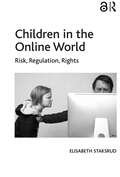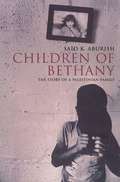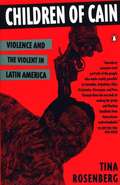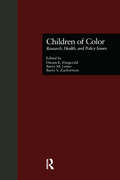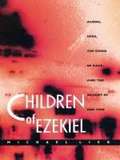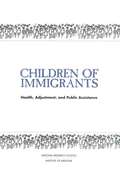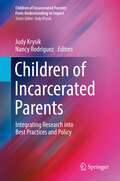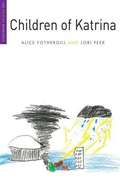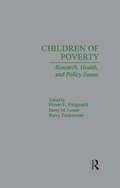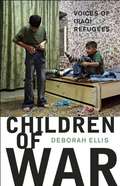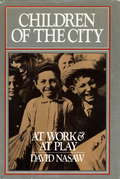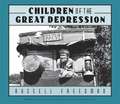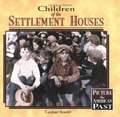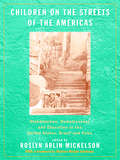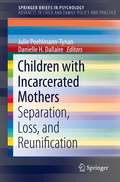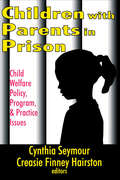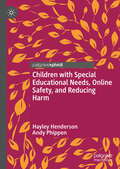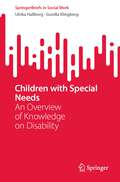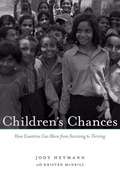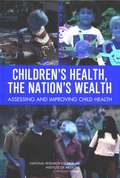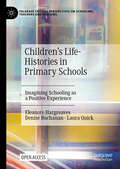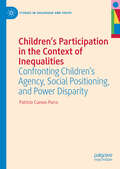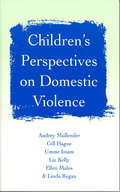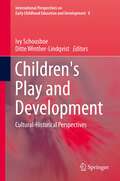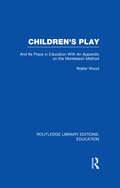- Table View
- List View
Children in the Online World: Risk, Regulation, Rights
by Elisabeth StaksrudWhat is online risk? How can we best protect children from it? Who should be responsible for this protection? Is all protection good? Can Internet users trust the industry? These and other fundamental questions are discussed in this book. Beginning with the premise that the political and democratic processes in a society are affected by the way in which that society defines and perceives risks, Children in the Online World offers insights into the contemporary regulation of online risk for children (including teens), examining the questions of whether such regulation is legitimate and whether it does in fact result in the sacrifice of certain fundamental human rights. The book draws on representative studies with European children concerning their actual online risk experiences as well as an extensive review of regulatory rationales in the European Union, to contend that the institutions of the western European welfare states charged with protecting children have changed fundamentally, at the cost of the level of security that they provide. In consequence, children at once have more rights with regard to their personal decision making as digital consumers, yet fewer democratic rights to participation and protection as ’digital citizens’. A theoretically informed, yet empirically grounded study of the relationship between core democratic values and the duty to protect young people in the media-sphere, Children in the Online World will appeal to scholars and students across the social sciences with interests in new technologies, risk and the sociology of childhood and youth.
Children of Bethany: The Story of a Palestinian Family
by Saïd K. AburishAburish unflinchingly writes of his family, telling of village life after WWI, the disruption after WWII, and the Palestinian diaspora which began then. His work gives an understanding of a culture, a family through time, and a tragedy of 20th century dislocation.
Children of Cain
by Tina RosenbergAn honest judge in Medellin, a Maoist guerilla of Peru's Shining Path, the fair-haired Angel of Death in Argentina's Dirty War, the pool-party rich of El Salvador, the disabused revolutionaries of Nicaragua, and the ordinary Chileans who became silent partners in Pinochet's dictatorship-these people live in Latin America, but their stories illuminate the human face of violence all over the world. Tina Rosenberg spent five years trying to understand their world and learning to live with these "children of Cain." Their stories are disturbing precisely because these people are not monsters; the faces in Children of Cain are not those of strangers.
Children of Color: Research, Health, and Policy Issues
by Barry M. Lester Hiram E. FitzgeraldBy the year 2050, the population of the United States is projected to be approximately half white and half non-white. Yet the knowledge of child development within ethnic minority groups lags markedly behind knowledge of child development for white Americans, and it is increasingly clear that the rich diversity within minority groups is masked by studies focusing on between-group comparisons. Children of Color: Research, Health, and Public Policy Issues , a collection of original essays, brings together researchers from the fields of education, family and child ecology, nursing, psychology, sociology, pediatrics, anthropology, and social work to explore the rich cultural, familial, and individual diversity of all ethnic minority groups. The essays were generated by round table discussions sponsored by the Society for Research in Child Development and the Irving Harris Foundation, and they cover a broad range of topics including immigration policy, social policy, health status of immigrant infants, children and families, and educational policies related to minority children.
Children of Ezekiel: Aliens, UFOs, the Crisis of Race, and the Advent of End Time
by Michael LiebAre Milton's Paradise Lost, Ronald Reagan's "Star Wars" missile defense program, our culture's fascination with UFOs and alien abductions, and Louis Farrakhan's views on racial Armageddon somehow linked? In Children of Ezekiel Michael Lieb reveals the connections between these phenomena and the way culture has persistently related the divine to the technological. In a work of special interest at the approach of the millennium, Lieb traces these and other diverse cultural moments--all descended from the prophet Ezekiel's vision of a fiery divine chariot in the sky--from antiquity to the present, across high and low culture, to reveal the pervasive impact of this visionary experience on the modern world. Beginning with the merkabah chariot literature of Hebrew and Gnostic mysticism, Lieb shows how religiously inspired people concerned with annihilating their heretical enemies seized on Ezekiel's vision as revealing the technologically superior instrument of God's righteous anger. He describes how many who seek to know the unknowable that is the power of God conceive it in technological terms--and how that power is associated with political aims and a heralding of the end of time. For Milton, Ezekiel's chariot becomes the vehicle in which the Son of God does battle with the rebellious angels. In the modern age, it may take the form of a locomotive, tank, airplane, missile, or UFO. Technology itself is seen as a divine gift and an embodiment of God in the temporal world. As Lieb demonstrates, the impetus to produce modern technology arises not merely from the desire for profit or military might but also from religious-spiritual motives. Including discussions of conservative evangelical Christian movements, Reagan's ballistic shooting gallery in the sky, and the Nation of Islam's vision of the "mother plane" as the vehicle of retribution in the war against racial oppression, Children of Ezekiel will enthrall readers who have been captivated, either through religious belief or intellectual interests, by a common thread uniting millennial religious beliefs, racial conflict, and political and militaristic aspirations.
Children of Immigrants: Health, Adjustment, and Public Assistance
by Institute of Medicine National Research CouncilImmigrant children and youth are the fastest-growing segment of the U.S. population, and so their prospects bear heavily on the well-being of the country. Children of Immigrants represents some of the very best and most extensive research efforts to date on the circumstances, health, and development of children in immigrant families and the delivery of health and social services to these children and their families.This book presents new, detailed analyses of more than a dozen existing datasets that constitute a large share of the national system for monitoring the health and well-being of the U.S. population. Prior to these new analyses, few of these datasets had been used to assess the circumstances of children in immigrant families. The analyses enormously expand the available knowledge about the physical and mental health status and risk behaviors, educational experiences and outcomes, and socioeconomic and demographic circumstances of first- and second-generation immigrant children, compared with children with U.S.-born parents.
Children of Incarcerated Parents: Integrating Research into Best Practices and Policy (Children of Incarcerated Parents: From Understanding to Impact)
by Nancy Rodriguez Judy KrysikThis book presents multidimensional knowledge on children of incarcerated parents using Bronfenbrenner’s ecological theory as an organizing framework. It examines the extent to which different levels of the environment are supportive (i.e., leading to resilience) and stress-producing (i.e., contributing to risk). The volume explores four levels of the environment – microsystem, mesosystem, exosystem, and macrosystem – with specific theories and paradigms woven into the inquiry at each. At the level of child and family, it discusses the factors that influence resilience and risk in children from gestation through young adulthood; at the community level, it addresses risk and resilience in the interactions between children and families and the various systems with which they interact (e.g., child welfare). Key areas of coverage include: · A description of the factors that influence the quality of programming for children and their families. · A critical analysis of state and national policies that affect which individuals receive, or fail to receive, specific services. · An overview and evaluation of the state of knowledge and implications for research and practice to improve outcomes for children of incarcerated parents. · An organizing framework to help researchers identify gaps in the existing knowledge base and distills and organizes evidence-based information for practitioners. Children of Incarcerated Parents is an essential resource for researchers, professors, and graduate students as well as practitioners, therapists, and other professionals in child and school psychology, family studies, public health, and all interrelated disciplines, including developmental psychology, criminal justice, social work, educational policy and politics.
Children of Katrina
by Lori Peek Alice FothergillWhen children experience upheaval and trauma, adults often view them as either vulnerable and helpless or as resilient and able to easily "bounce back. " But the reality is far more complex for the children and youth whose lives are suddenly upended by disaster. How are children actually affected by catastrophic events and how do they cope with the damage and disruption?Children of Katrina offers one of the only long-term, multiyear studies of young people following disaster. Sociologists Alice Fothergill and Lori Peek spent seven years after Hurricane Katrina interviewing and observing several hundred children and their family members, friends, neighbors, teachers, and other caregivers. In this book, they focus intimately on seven children between the ages of three and eighteen, selected because they exemplify the varied experiences of the larger group. They find that children followed three different post-disaster trajectories-declining, finding equilibrium, and fluctuating-as they tried to regain stability. The children's moving stories illuminate how a devastating disaster affects individual health and well-being, family situations, housing and neighborhood contexts, schooling, peer relationships, and extracurricular activities. This work also demonstrates how outcomes were often worse for children who were vulnerable and living in crisis before the storm. Fothergill and Peek clarify what kinds of assistance children need during emergency response and recovery periods, as well as the individual, familial, social, and structural factors that aid or hinder children in getting that support.
Children of Poverty: Research, Health, and Policy Issues (Reference Books On Family Issues #Vol. 23)
by Hiram E. Fitzgerald; Barry M. Lester; Barry ZuckermanA collection of the Proceedings of a Society for Research in Child Development Round Table, held in 1993 by the Society for Research in Child Development (SRCD).The intent of the round tables was "to help chart the course for child development research, health care, and public policy for the next ten years". The contributors believe the papers presented and the round table discussions, along with their broader distribution in this volume, do indeed offer useful insights and powerful guidance to researchers, policy makers, and practitioners and interventionists with a vast range of professional training.
Children of War: Voices of Iraqi Refugees
by Deborah EllisFive years have passed since the U.S. and its allies invaded Iraq, and true democracy has yet to come. Four million Iraqis have been displaced; half are living in desolate tent camps, the others mostly stuck in Jordan and Syrian. All face uncertain futures. In this book, Deborah Ellis turns her attention to the war's most tragic victims -- Iraqi children. She interviews more than 20 young Iraqis, mostly refugees living in Jordan, but also a few trying to build new lives in North America. Some families left Iraq with money; others are penniless, ill, or disabled. Most of the parents are working illegally or not at all, and the fear of deportation is a constant threat. The children speak for themselves, with little editorial comment, and their stories are frank, harrowing, and often reveal a surprising resilience in surviving the consequences of a war in which they played no part.
Children of the City: At Work and At Play
by David NasawA surprising and indelible portrait of the bitter hardships, amazing resourcefulness and unadulterated joys experienced by immigrant children in American metropolises at the turn of the century. The turn of the twentieth century was a time of explosive growth for American cities, a time of nascent hopes and apparently limitless possibilities. In Children of the City, David Nasaw re-creates this period in our social history from the vantage point of the children who grew up then. Drawing on hundreds of memoirs, autobiographies, oral histories and unpublished--and until now unexamined--primary source materials from cities across the country, he provides us with a warm and eloquent portrait of these children, their families, their daily lives, their fears, and their dreams. The true story of the Newsies who successfully organized and struck the newspaper empires of Hearst and Pulitzer.
Children of the Great Depression
by Russell FreedmanAs he did for frontier children in his enormously popular Children of the Wild West, Russell Freedman illuminates the lives of the American children affected by the economic and social changes of the Great Depression. Middle-class urban youth, migrant farm laborers, boxcar kids, children whose families found themselves struggling for survival . . . all Depression-era young people faced challenges like unemployed and demoralized parents, inadequate food and shelter, schools they couldn't attend because they had to go to work, schools that simply closed their doors. Even so, life had its bright spots-like favorite games and radio shows-and many young people remained upbeat and optimistic about the future. Drawing on memoirs, diaries, letters, and other firsthand accounts, and richly illustrated with classic archival photographs, this book by one of the most celebrated authors of nonfiction for children places the Great Depression in context and shows young readers its human face. Endnotes, selected bibliography, index.
Children of the Settlement Houses
by Caroline ArnoldIn the 1880s and 1890s, immigrants from Europe poured into American cities. Most lived in horrific poverty, lacking even such basic services as electricity or running water. A number of idealistic women and men of the middle classes moved into these poverty-wracked neighborhoods and tried to help. These "settlers" worked to bring cultural opportunities to their neighbors and to improve living conditions. From New York to San Francisco they founded some 400 community centers, or settlement houses, where people could gather to study and have fun. This book introduces young children to the settlement house movement and suggests projects to bring settlement history to life.
Children on the Streets of the Americas: Globalization, Homelessness and Education in the United States, Brazil, and Cuba
by Roslyn Arlin MickelsonFirst published in 2000. Routledge is an imprint of Taylor & Francis, an informa company.
Children with Incarcerated Mothers: Separation, Loss, and Reunification (SpringerBriefs in Psychology)
by Julie Poehlmann-Tynan Danielle H. DallaireThis Brief focuses on children with incarcerated mothers, a growing and vulnerable population. It presents five empirical studies, along with an introduction and summary chapter. The five empirical chapters examine new qualitative and quantitative data on: Typical occurrences when pregnant women give birth during incarceration in contrast with the benefits of a prison doula program for mothers and newborns. A mother’s criminal justice involvement for substance abuse crimes and its effects on children’s protective services involvement and foster care placement. How children cope with separation from their mothers because of their incarceration and how that separation continues to affect children's lives following family reunification. Differences in recidivism trajectories between mothers and nonmothers during the 10 years following release from incarceration. Alternatives to incarceration for women in residential drug treatment and how community supervision mandates can affect, contribute to, or extend mother-child separation. The final chapter integrates the information from the empirical studies and summarizes implications for policy and practice. Children with Incarcerated Mothers is an essential resource for policy makers and related professionals, graduate students, and researchers in child and school psychology, family studies, public health, social work, law/criminal justice, and sociology.
Children with Parents in Prison: Child Welfare Policy, Program, and Practice Issues
by Cynthia Seymour Creasie Finney HairstonAdults are being incarcerated in the United States at an ever-escalating rate, and child welfare professionals are encountering growing numbers of children who have parents in prison. Current estimates indicate that as many as 1.5 million children have an incarcerated parent; many thousands of others have experienced the incarceration of a parent at some point in their lives. These vulnerable children face unique difficulties, and their growing numbers and special needs demand attention.Existing literature indicates that children whose parents are incarcerated experience a variety of negative consequences, particularly in terms of their emotional health and well being. They also may have difficult interactions or limited contact with their parents. There are also issues connected with their physical care and child custody. The many challenges facing the child welfare system as it attempts to work with this population are explored in Children with Parents in Prison. Topics covered include: ""Supporting Families and Children of Mothers in Jail""; ""Meeting the Challenge of Permanency Planning for Children with Incarcerated Mothers""; ""The Impact of Changing Public Policy on Relatives Caring for Children with Incarcerated Parents""; ""Legal Issues and Recommendations""; ""Facilitating Parent-Child Contact in Correctional Settings""; ""Earning Trust from Youths with None to Spare""; ""Developing Quality Services for Offenders and Families""; and in closing, ""Understanding the Forces that Influence Incarcerated Fathers' Relationships with Their Children.""Children and families have long struggled with the difficulties created when a parent goes to prison. What is new is the magnitude of the problem. This volume calls for increased public awareness of the impact of parental incarceration on children. Its goal is to stimulate discussion about how to best meet the special needs of these children and families and how to provide a resource for the child welfare community as it responds to
Children with Special Educational Needs, Online Safety, and Reducing Harm
by Andy Phippen Hayley HendersonThis book explores the online behavior and safeguarding of children with special education needs (SEN) in the digital world. Founded in research which evidences key stakeholder perspectives, this book informs and guides stakeholders towards sensibly balancing risk and opportunities online with an understanding that SEN children may face some unique challenges that can place them at greater risk. To develop a child-centered approach, the authors employ an ecosystems theory approach which considers child development as a system of interrelated relationships affected by multiple levels of surrounding environment, drawing upon Bronfenbrenner's seminal work and positioning the research within the field of education.
Children with Special Needs: An Overview of Knowledge on Disability (SpringerBriefs in Social Work)
by Ulrika Hallberg Gunilla KlingbergThere can be a lack of understanding of the vulnerable situation of children with disabilities and their families, even among professional caregivers whose mission is to protect the health and wellbeing of these children. Their respectful treatment should include knowledge, empathy, humanity, and an open and sympathetic dialogue. This book provides an overview of knowledge and literature review of children and adolescents with special care needs that contribute to the respect and understanding of children with disabilities and their families. It also explains possible reasons for different outcomes in research studies and why there is a lack of knowledge in some areas concerning these children. Research on children with disabilities is considerable but often can be difficult to access on many levels, which means it does not always benefit those who need this knowledge. This compact book addresses this by presenting the international research in the field in an understandable way for people who work with children with disabilities and their families. The authors provide a broad picture of the background, reality of life, opportunities for professional help and support, as well as outlook of these children and families. Among the topics covered:The Health and Well-being of Children with DisabilitiesThe Health and Well-being of RelativesOccupationOn the Road to AdulthoodChildren with Special Needs: An Overview of Knowledge on Disability is pertinent reading for students in all areas of health care (including nursing and psychology), social work, sociology, and education aimed at children and young people. The text also would be of interest to those who practice in these areas and/or encounter children with disabilities in their daily work.
Children's Chances
by Jody HeymannChildren’s Chances urges a shift from focusing on survival to targeting children’s full and healthy development. Drawing on comparative data on policies in 190 countries designed to combat poverty, discrimination, child labor, illiteracy, and child marriage, Heymann and McNeill tell what works to ensure equal opportunities for all children.
Children's Health, The Nation's Wealth: Assessing And Improving Child Health
by National Research Council Institute of Medicine of the National AcademiesChildren&#39s health has clearly improved over the past several decades. Significant and positive gains have been made in lowering rates of infant mortality and morbidity from infectious diseases and accidental causes, improved access to health care, and reduction in the effects of environmental contaminants such as lead. Yet major questions still remain about how to assess the status of children's health, what factors should be monitored, and the appropriate measurement tools that should be used. Children's Health, the Nation's Wealth: Assessing and Improving Child Health provides a detailed examination of the information about children's health that is needed to help policy makers and program providers at the federal, state, and local levels. In order to improve children's health -- and, thus, the health of future generations -- it is critical to have data that can be used to assess both current conditions and possible future threats to children's health. This compelling book describes what is known about the health of children and what is needed to expand the knowledge. By strategically improving the health of children, we ensure healthier future generations to come.
Children's Life-Histories in Primary Schools: Imagining Schooling as a Positive Experience (Palgrave Critical Perspectives on Schooling, Teachers and Teaching)
by Eleanore Hargreaves Laura Quick Denise BuchananThis open access book explores schooling from the perspective of children via data from a longitudinal life-history study. It questions whether schooling creates an environment where all children to flourish; or whether a policy focus on attainment in mathematics and English hinders some children’s wellbeing and learning. By drawing on the children’s life-history narratives and their ideas, the chapters also portray children’s realistic suggestions for practices that meet the needs of diverse children and strengthen their comprehensive wellbeing and learning within schooling.
Children's Participation in the Context of Inequalities: Confronting Children's Agency, Social Positioning, and Power Disparity (Studies in Childhood and Youth)
by Patricio Cuevas-ParraThis book takes up theoretical and practical discussions of children and young people's participation in public decision-making by taking into account existing literature from throughout childhood studies, sociology of childhood, children's human rights studies, decolonization studies, and intersectionality studies. Through case studies conducted in Brazil, Bangladesh, Sierra Leone, and Ghana, Cuevas-Parra provides extensive empirical data from beyond the Global North and confronts dominant views of power, inequalities, and agency. The understanding that children and young people are immersed in intersectional social structures, where they are never 'simply children' but individuals with multiple specific identities, cuts across the book.
Children's Perspectives on Domestic Violence
by Liz Kelly Linda Regan Gill Hague Audrey Mullender Umme F. Imam Ellen Malos`The research methodology and the problems encountered when studying a subject such as domestic violence, coupled with the ethical problems of researching with children, are discussed at length in the book. This gives a good insight into the intricacies of conducting such a research study. The research looked not only at children who were known to have direct contact with domestic violence, but also what children in general thought and felt about domestic violence. The presentation of the findings, both in tabular and narrative form, was well presented' - Accident and Emergency Nursing Journal `This book offers accessible and interesting reading. It is well written as one would expect from these authors.... There are a lot of pointers for the way forward in terms of both policy and practice. This is likely to become a seminal text' - Research Policy and Planning 'This is a useful and challenging read for all of us who seek to work effectively and ethically in this complex area of practice' - Professional Social Work `Just looking at the authors of this book tells the reader that they are about to embark on a pioneering piece of academic research... a comprehensive and authoritative piece of work' - Domestic Abuse Quarterly `A vital tool for all those working with children' - ChildRight 'Written in a lucid style and is easy to read... it is essential reading for all students in social work undergraduate courses and also in post-qualifying courses on child welfare and protection. In addition professionals who are directly working in the area of child protection, schools and criminal justice settings would find this book informative and useful in understanding what children and young people want, and need, in relation to living in domestic violence situations' - Child and Family Social Work 'This book is powerfully written and is essential reading for professional working with and supporting abused women and their children. Its groundbreaking focus on children's experiences adds much to our understanding of the complexities of domestic violence' - Journal of Family Studies 'A treasure-chest of rich, diverse and powerful extracts from children and young people... in particular the material presented on different coping strategies used by children who have experienced domestic violence is an important contribution to an area about which very little is known' - Adoption and Fostering Journal How do children who live with domestic violence cope? How do they make sense of their experiences? Do they receive the right sort of help from formal and informal sources? Drawing on the newest research designed to hear the voices of children and young people, this important book examines children's experiences and perspectives on living with domestic violence. The authors explore: - the effect of domestic violence on children - what children say would help them most in coping with domestic violence - the advice children would offer other children who find themselves in similar circumstances, their mothers and the helping professions. This accessible book written for students, their teachers, researchers and all those working with children - across social work, health, child psychology and psychiatry, the law and education - will provide a vital insight into children's own perspectives on domestic violence.
Children's Play and Development: Cultural-Historical Perspectives (International Perspectives on Early Childhood Education and Development #8)
by Ditte Winther-Lindqvist Ivy SchousboeThis book provides new theoretical insights to our understanding of play as a cultural activity. All chapters address play and playful activities from a cultural-historical theoretical approach by re-addressing central claims and concepts in the theory and providing new models and understandings of the phenomenon of play within the framework of cultural historical theory. Empirical studies cover a wide range of institutional settings: preschool, school, home, leisure time, and in various social relations (with peers, professionals and parents) in different parts of the world (Europe, Australia, South America and North America). Common to all chapters is a goal of throwing new light on the phenomenon of playing within a theoretical framework of cultural-historical theory. Play as a cultural, collective, social, personal, pedagogical and contextual activity is addressed with reference to central concepts in relation to development and learning. Concepts and phenomena related to ZPD, the imaginary situation, rules, language play, collective imagining, spheres of realities of play, virtual realities, social identity and pedagogical environments are presented and discussed in order to bring the cultural-historical theoretical approach into play with contemporary historical issues. Essential as a must read to any scholar and student engaged with understanding play in relation to human development, cultural historical theory and early childhood education.
Children's Play and Its Place in Education: With an Appendix on the Montessori Method (Routledge Library Editions: Education)
by Walter De Burley WoodPublished long before the importance of early childhood education was formally recognised in the educational landscape this book explores the significance of play for young children. The volume includes an appendix on Montessori education.
